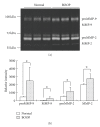Bronchiolitis obliterans organizing pneumonia in Swine associated with porcine circovirus type 2 infection
- PMID: 20976305
- PMCID: PMC2952812
- DOI: 10.1155/2011/245728
Bronchiolitis obliterans organizing pneumonia in Swine associated with porcine circovirus type 2 infection
Abstract
Bronchiolitis obliterans organizing pneumonia (BOOP) is a chronic respiratory disease. Although the pathogenesis of BOOP is still incompletely understood, BOOP is responsive to steroids and has a good prognosis. In our five pigs with chronic postweaning multisystemic wasting syndrome (PMWS), typical BOOP lesions were revealed. All five porcine lungs showed typical intraluminal plugs, and porcine circovirus type 2 (PCV2) was identified. They also exhibited similar pathologic findings such as proliferation of type II pneumocytes and myofibroblasts (MFBs), extracellular collagen matrix (ECM) deposition, and fragmentation of elastic fibers. MFBs migration correlative molecules, for instance, gelatinase A, B and osteopontin, appeared strongly in the progressing marginal area of polypoid intraluminal plugs of fibrotic lesion. These molecules colocalized with the active MFBs. Both gelatinase activity and intercellular level of active MFBs were significantly increased (P < .05). Porcine chronic bronchopneumonia leads to BOOP and it is associated with PCV2 persistent infection. Swine BOOP demonstrates similar cellular constituents with human BOOP. Perhaps their molecular mechanisms of pathogenesis operate in a similar way. Thus we infer that the swine BOOP can be considered as a potential animal model for human BOOP associated with natural viral infection. Moreover, it is more convenient to obtain samples.
Figures





Similar articles
-
Pathological findings associated with naturally acquired porcine circovirus type 2 associated disease.Vet Microbiol. 2004 Feb 4;98(2):137-49. doi: 10.1016/j.vetmic.2003.10.006. Vet Microbiol. 2004. PMID: 14741126 Review.
-
Reproduction of postweaning multisystemic wasting syndrome (PMWS) in immunostimulated and non-immunostimulated 3-week-old piglets experimentally infected with porcine circovirus type 2 (PCV2).Vet Microbiol. 2002 Oct 22;89(2-3):97-114. doi: 10.1016/s0378-1135(02)00174-8. Vet Microbiol. 2002. PMID: 12243888 Free PMC article.
-
Reproduction of lesions of postweaning multisystemic wasting syndrome by infection of conventional pigs with porcine circovirus type 2 alone or in combination with porcine parvovirus.J Comp Pathol. 2000 Jan;122(1):9-24. doi: 10.1053/jcpa.1999.0337. J Comp Pathol. 2000. PMID: 10627387
-
Experimental reproduction of postweaning multisystemic wasting syndrome in pigs by dual infection with Mycoplasma hyopneumoniae and porcine circovirus type 2.Vet Pathol. 2004 Nov;41(6):624-40. doi: 10.1354/vp.41-6-624. Vet Pathol. 2004. PMID: 15557072
-
Porcine circovirus diseases.Anim Health Res Rev. 2005 Dec;6(2):119-42. doi: 10.1079/ahr2005106. Anim Health Res Rev. 2005. PMID: 16583778 Review.
Cited by
-
Chronic interstitial pneumonia with features of organizing pneumonia in an adult horse.J Vet Diagn Invest. 2020 Jul;32(4):621-625. doi: 10.1177/1040638720936251. J Vet Diagn Invest. 2020. PMID: 32687009 Free PMC article.
-
Rattus model utilizing selective pulmonary ischemia induces bronchiolitis obliterans organizing pneumonia.Shock. 2013 Mar;39(3):271-7. doi: 10.1097/SHK.0b013e318281a58c. Shock. 2013. PMID: 23364425 Free PMC article.
-
The occurrence of porcine circovirus 3 without clinical infection signs in Shandong Province.Transbound Emerg Dis. 2017 Oct;64(5):1337-1341. doi: 10.1111/tbed.12667. Epub 2017 Jun 26. Transbound Emerg Dis. 2017. PMID: 28653486 Free PMC article.
-
Identification of the Effects of 5-Azacytidine on Porcine Circovirus Type 2 Replication in Porcine Kidney Cells.Vet Sci. 2024 Mar 20;11(3):135. doi: 10.3390/vetsci11030135. Vet Sci. 2024. PMID: 38535869 Free PMC article.
-
Histopathological analogies in chronic pulmonary lesions between cattle and humans: basis for an alternative animal model.ScientificWorldJournal. 2012;2012:647403. doi: 10.1100/2012/647403. Epub 2012 May 2. ScientificWorldJournal. 2012. PMID: 22629176 Free PMC article. Review.
References
-
- Lange W. Ueber eine eigenthumliche Erkrankung der kleinen Bronchien und Bronchilen. Deutsches Archiv für Klinische Medizin. 1901;70:324–364.
-
- Epler GR, Colby TV, McLoud TC, Carrington CB, Gaensler EA. Bronchiolitis obliterans organizing pneumonia. The New England Journal of Medicine. 1985;312(3):152–158. - PubMed
-
- Epler GR. Bronchiolitis obliterans organizing pneumonia: definition and clinical features. Chest. 1992;102(supplement 1):2S–6S. - PubMed
-
- Rose N, Larour G, Le Diguerher G, et al. Risk factors for porcine post-weaning multisystemic wasting syndrome (PMWS) in 149 French farrow-to-finish herds. Preventive Veterinary Medicine. 2003;61(3):209–225. - PubMed
-
- López-Soria S, Segalés J, Rose N, et al. An exploratory study on risk factors for postweaning multisystemic wasting syndrome (PMWS) in Spain. Preventive Veterinary Medicine. 2005;69(1-2):97–107. - PubMed
Publication types
MeSH terms
Substances
LinkOut - more resources
Full Text Sources
Research Materials
